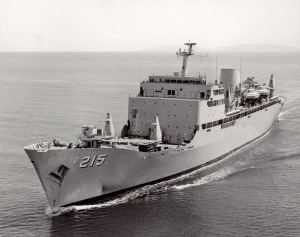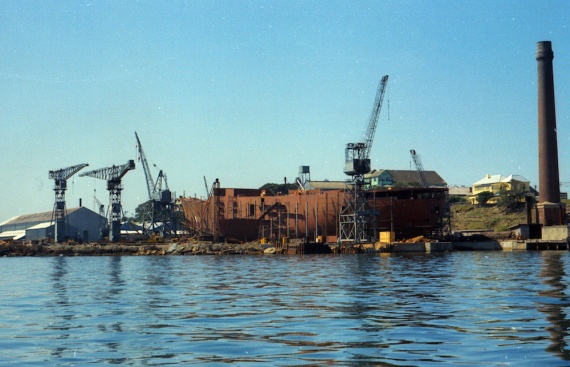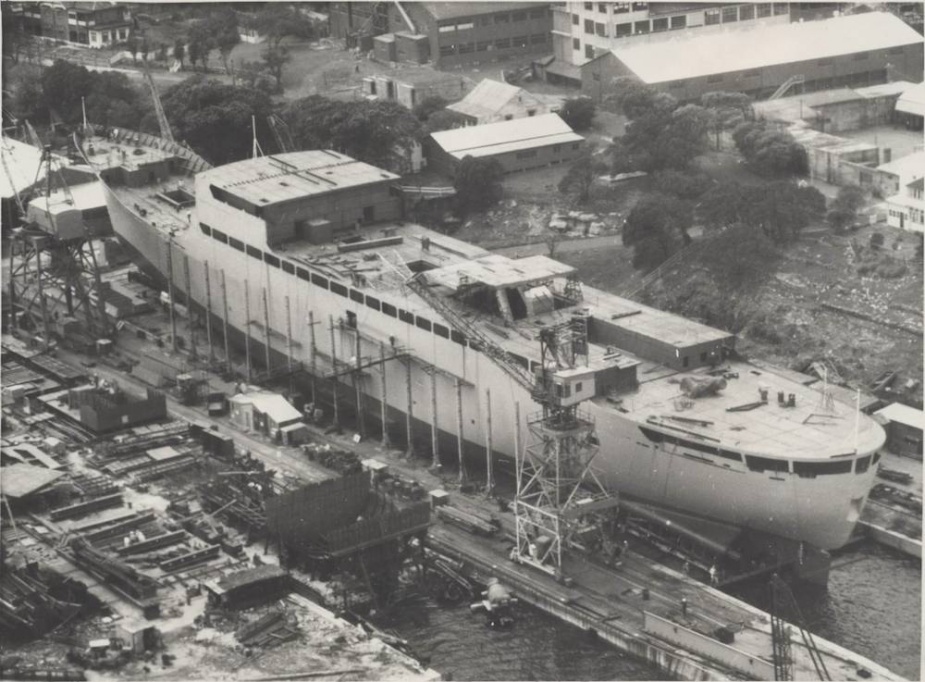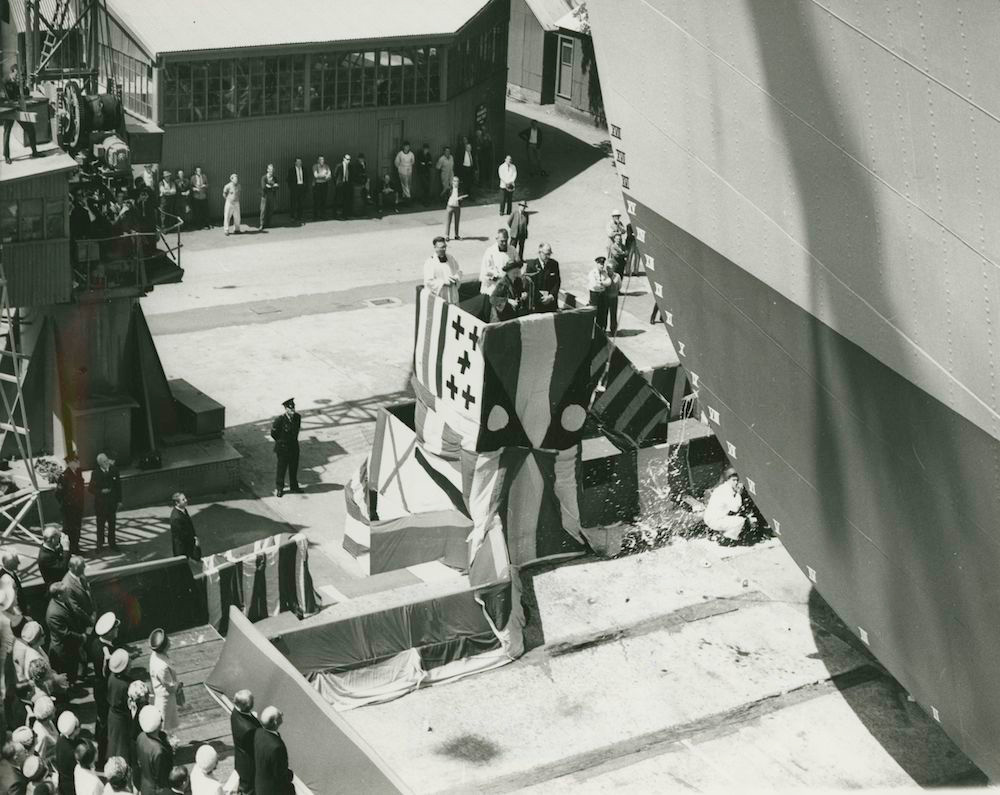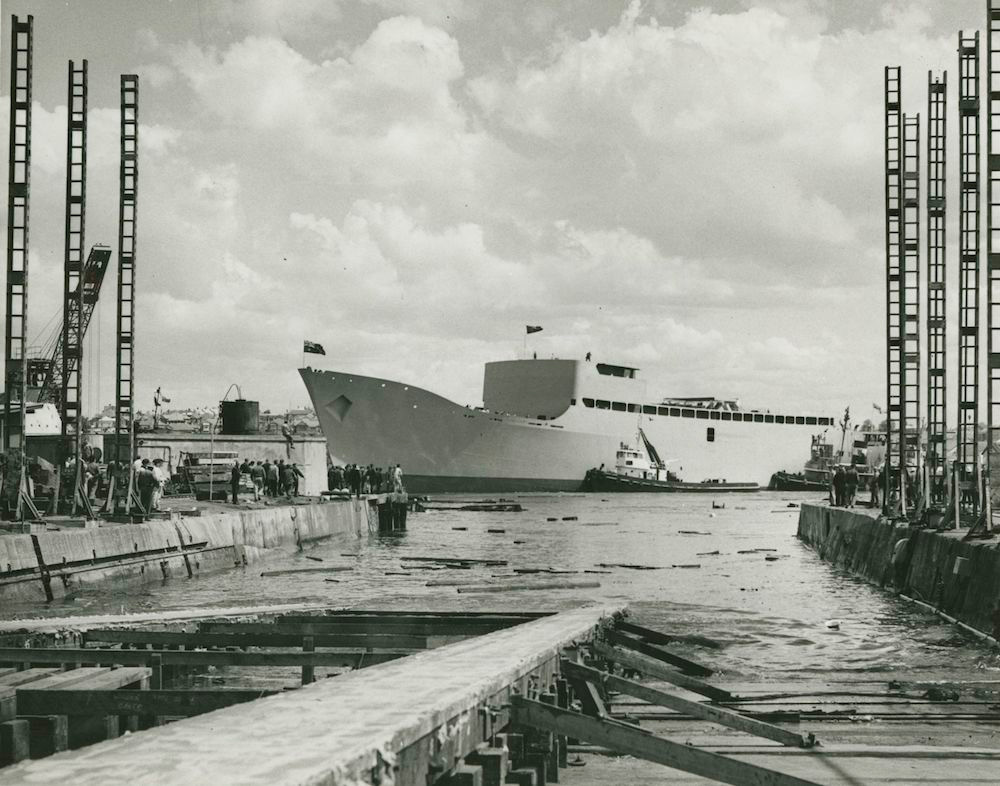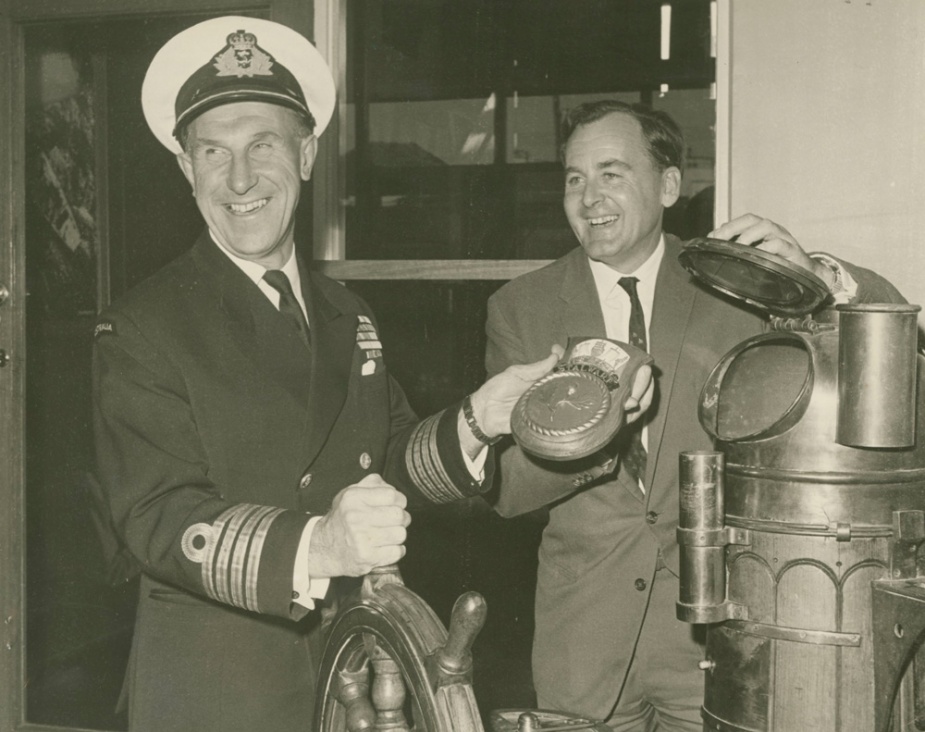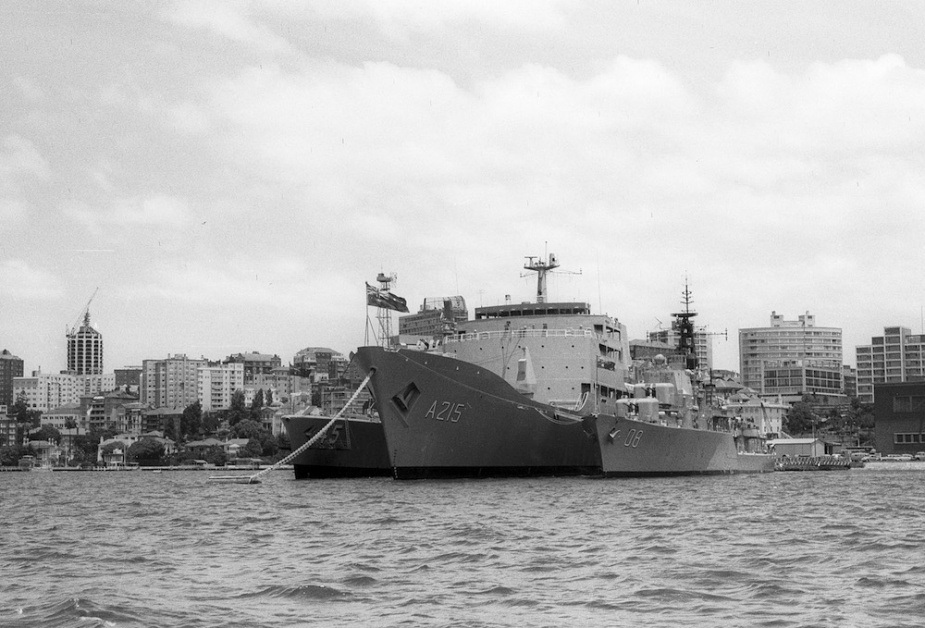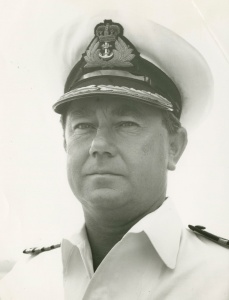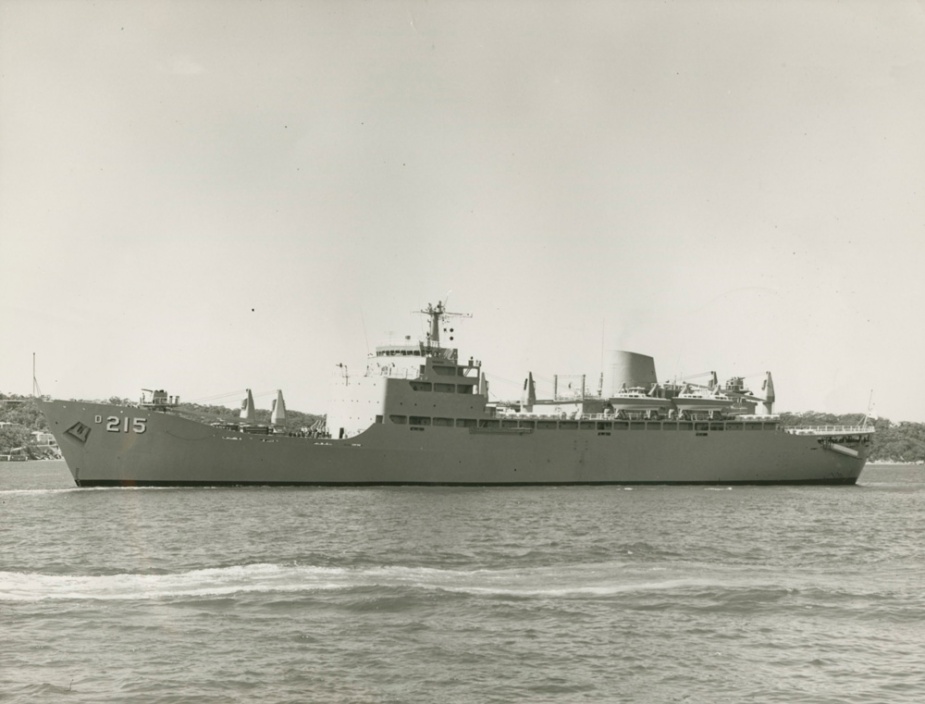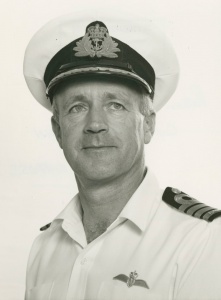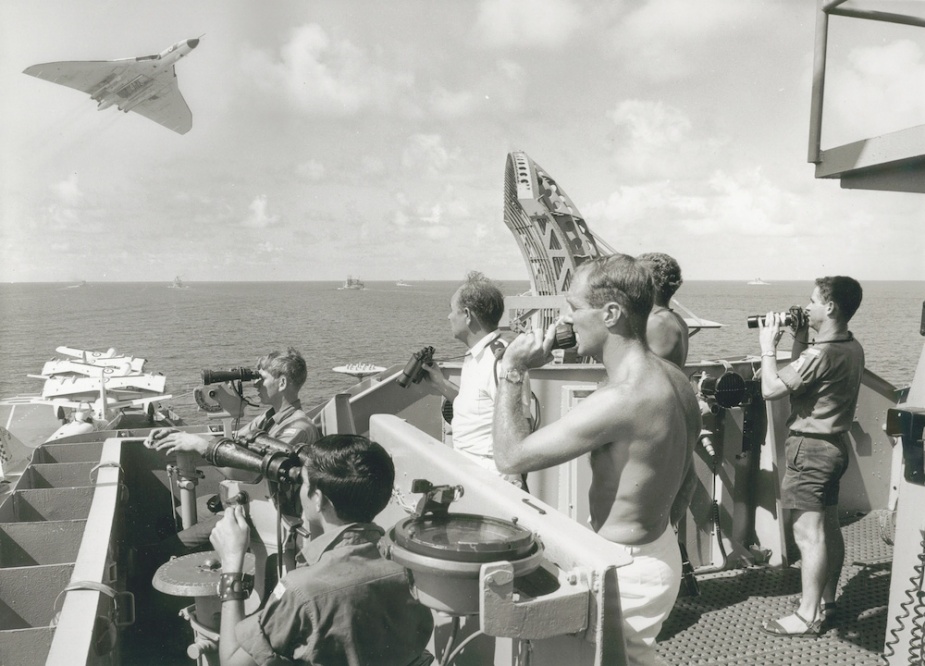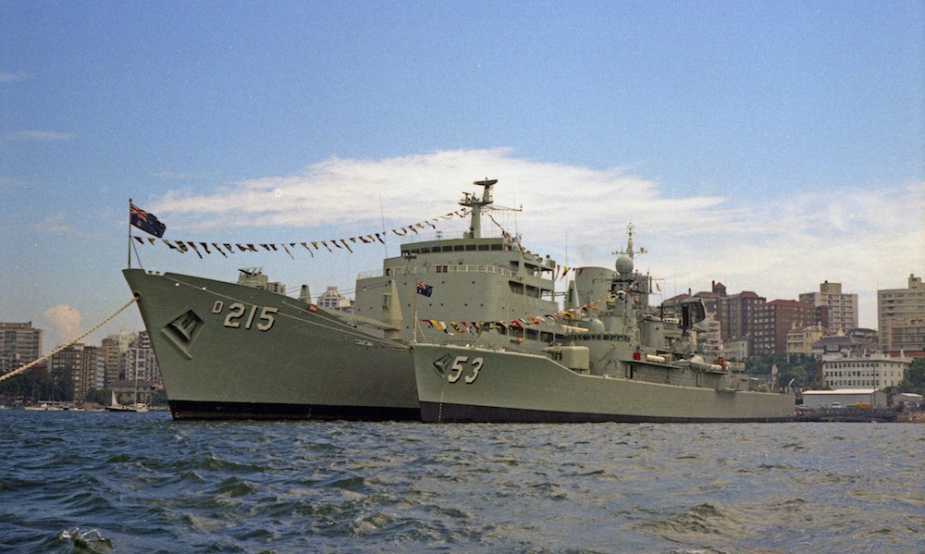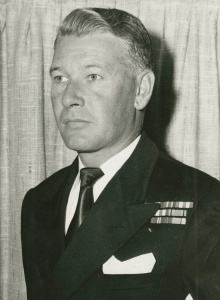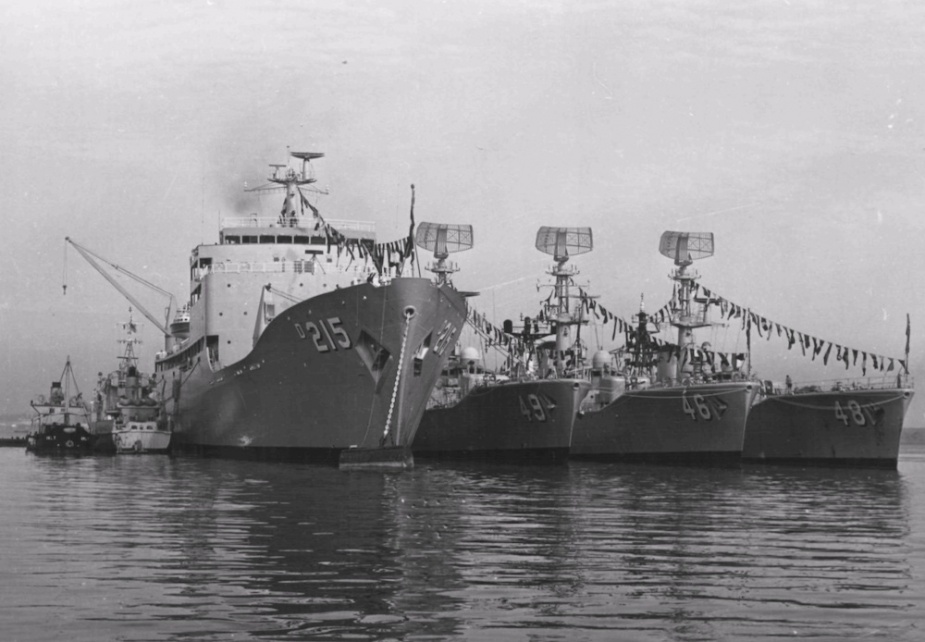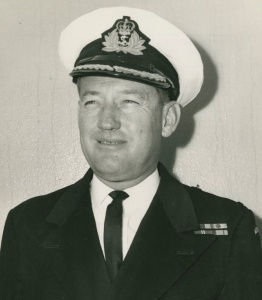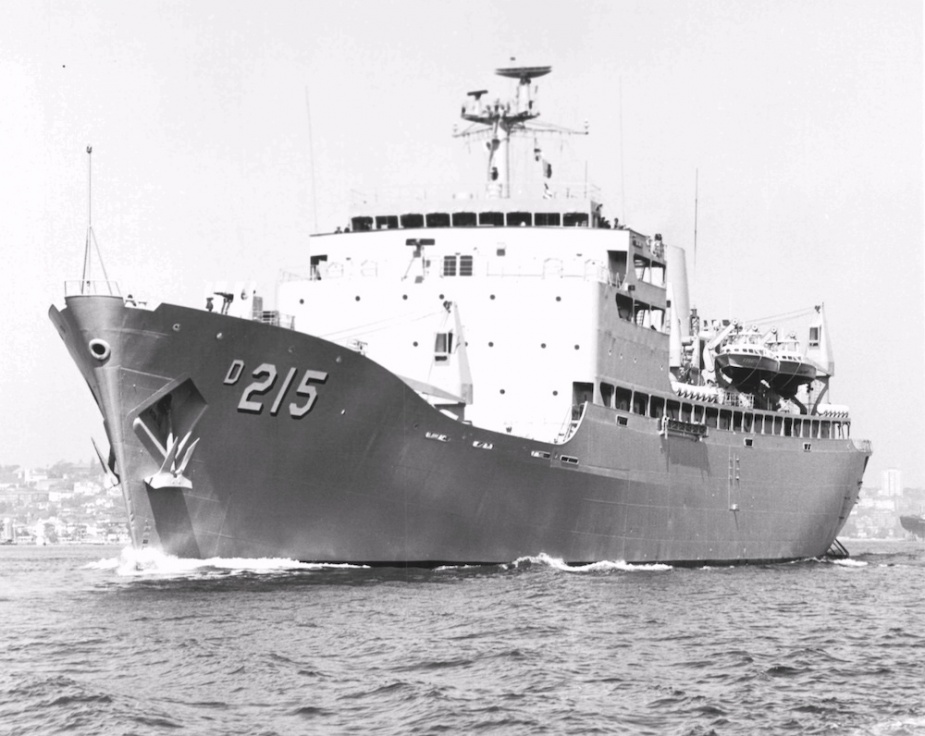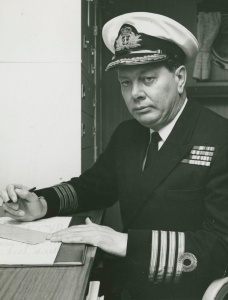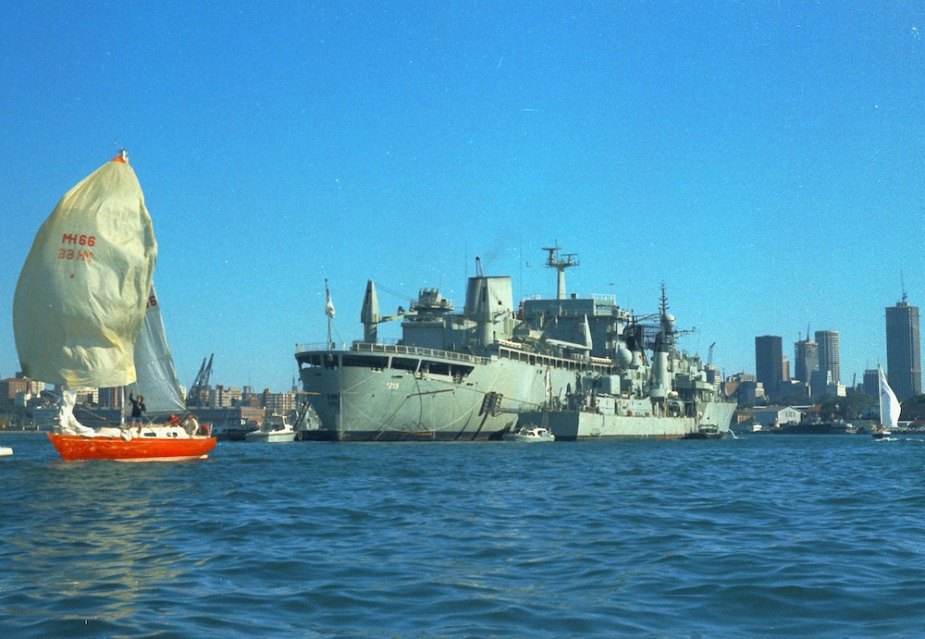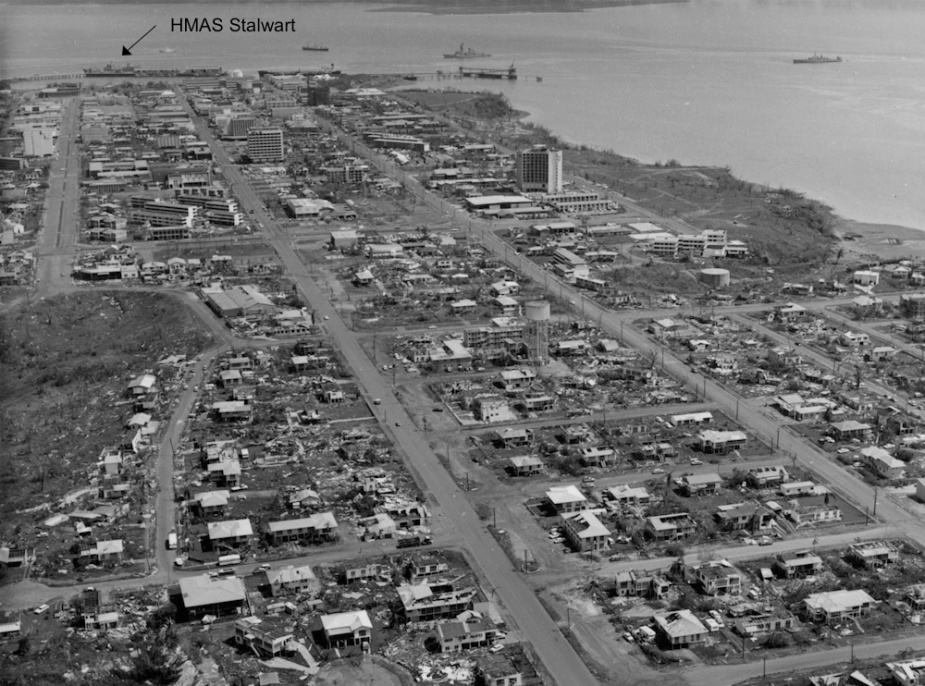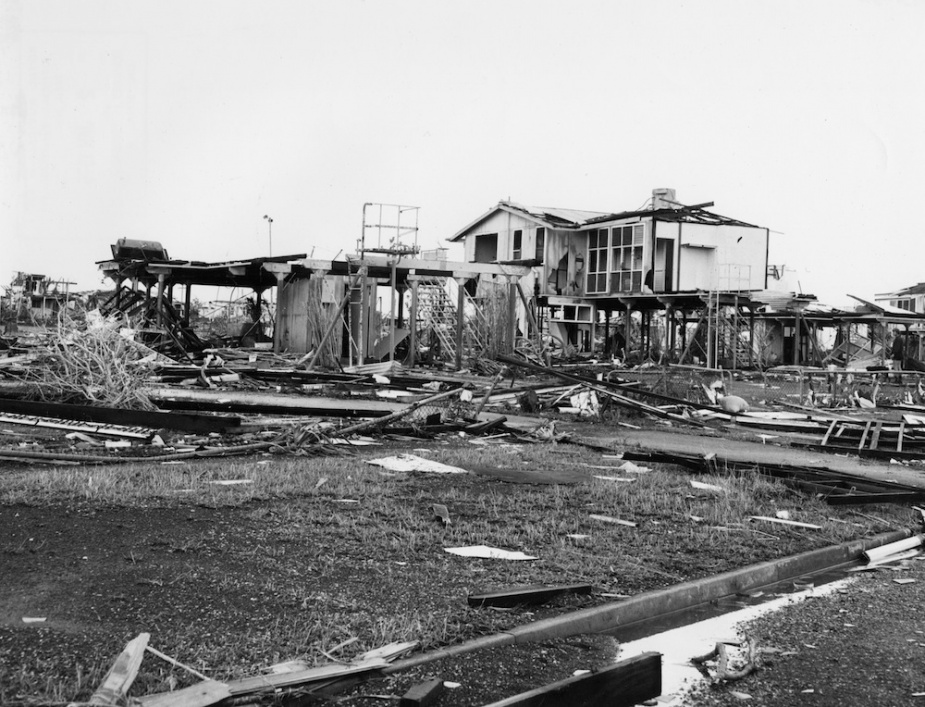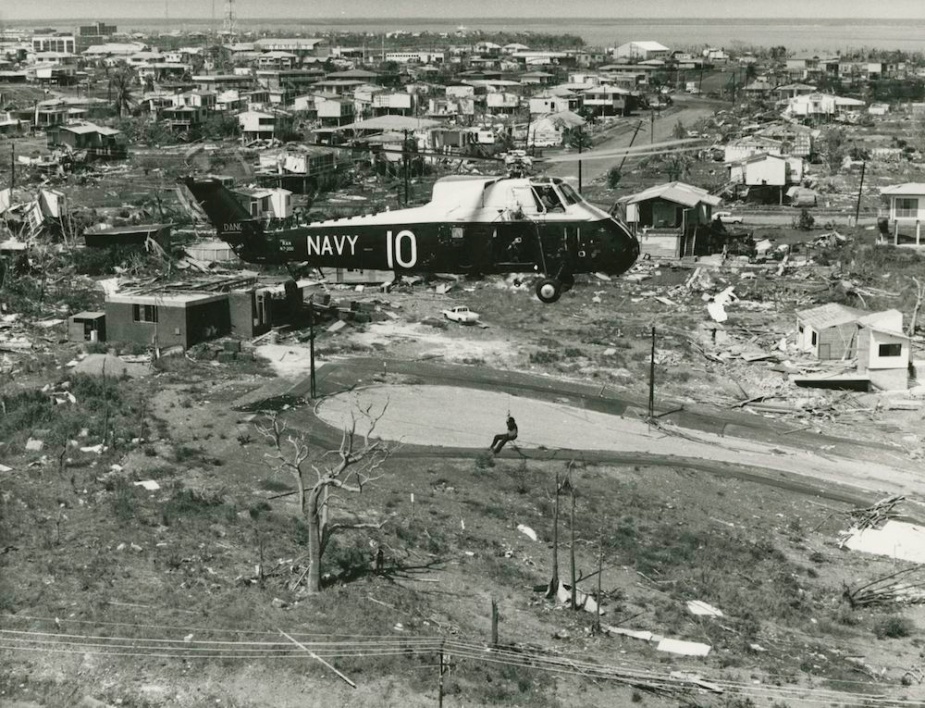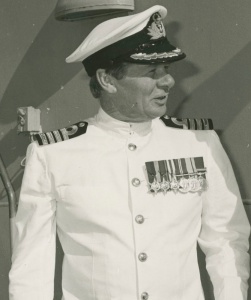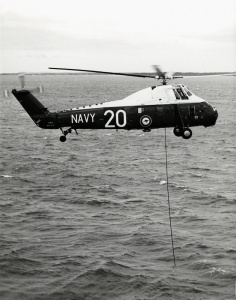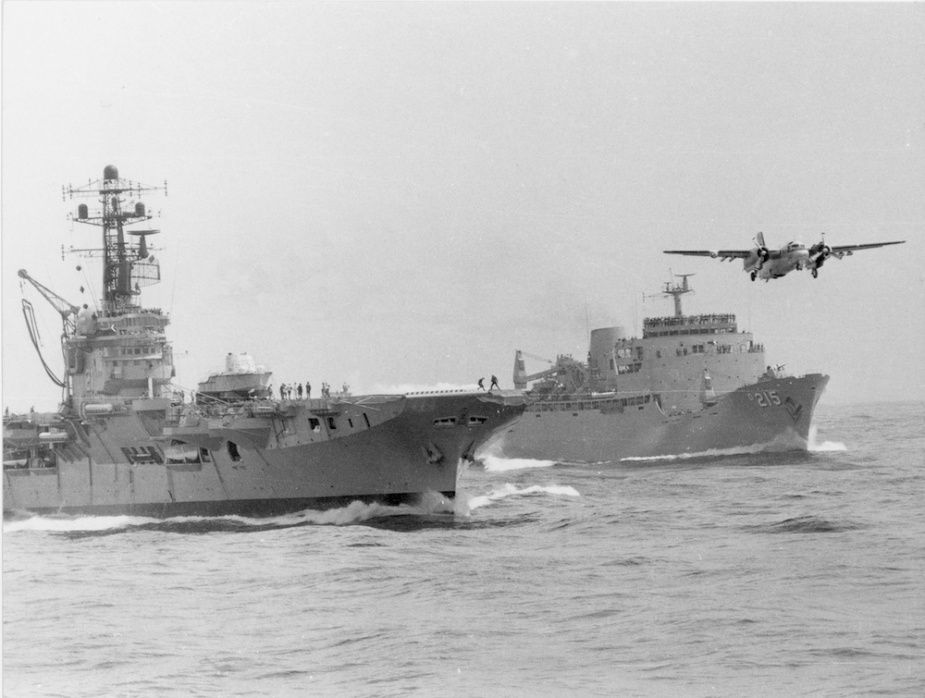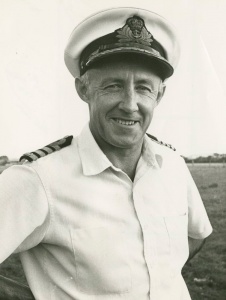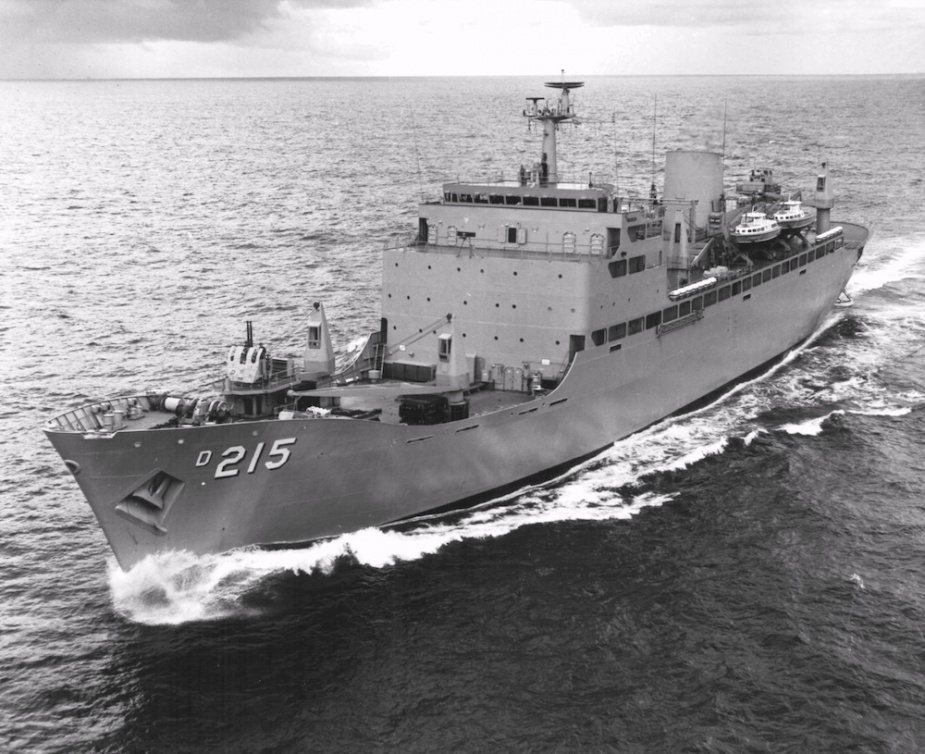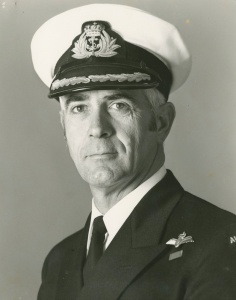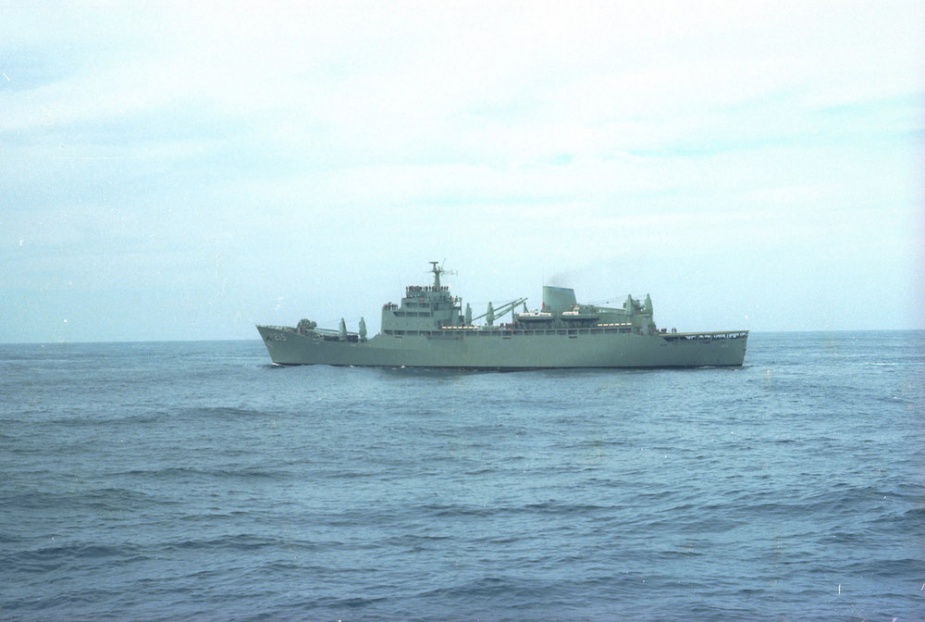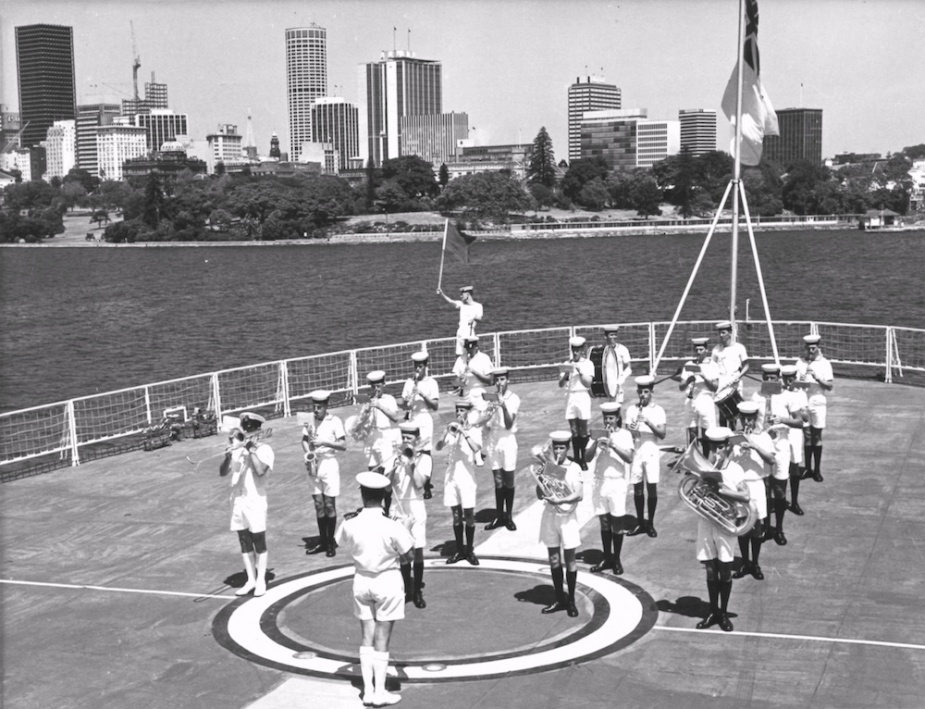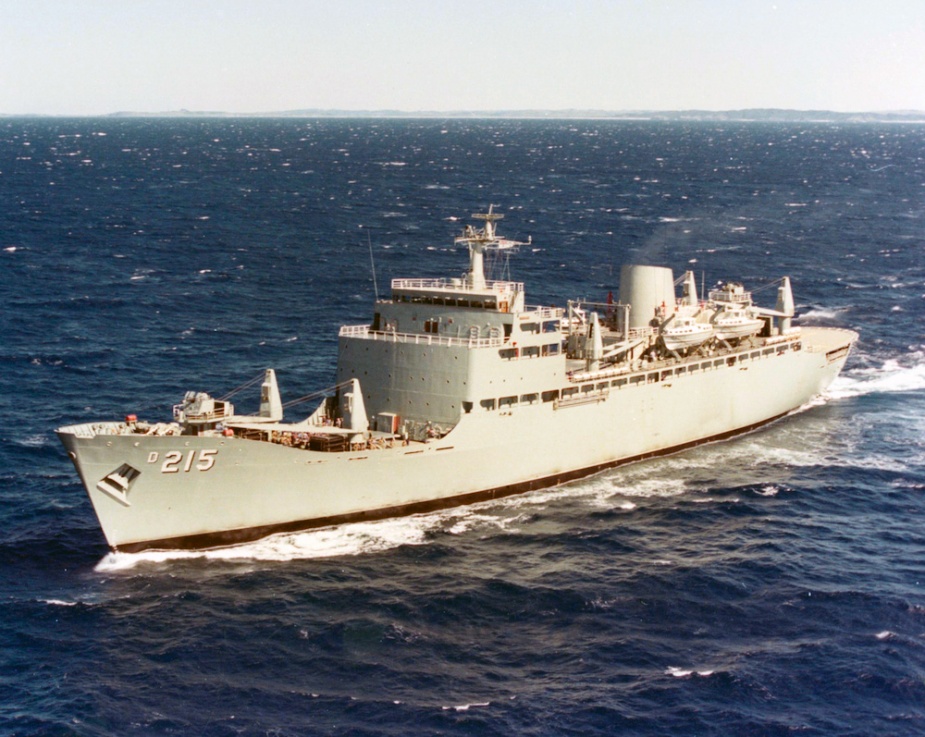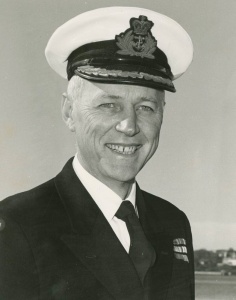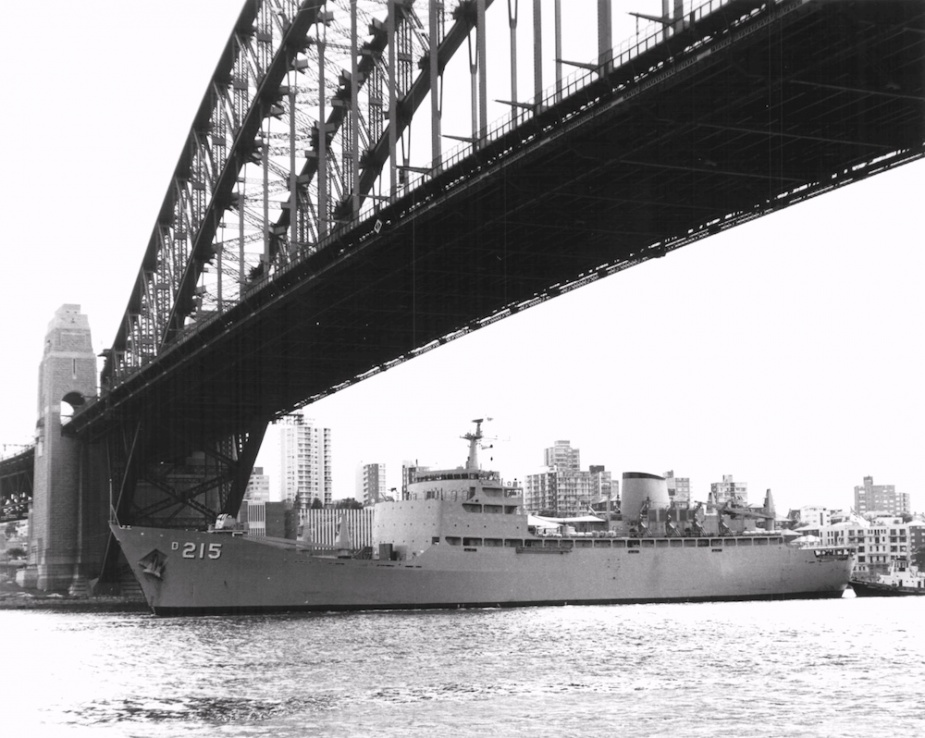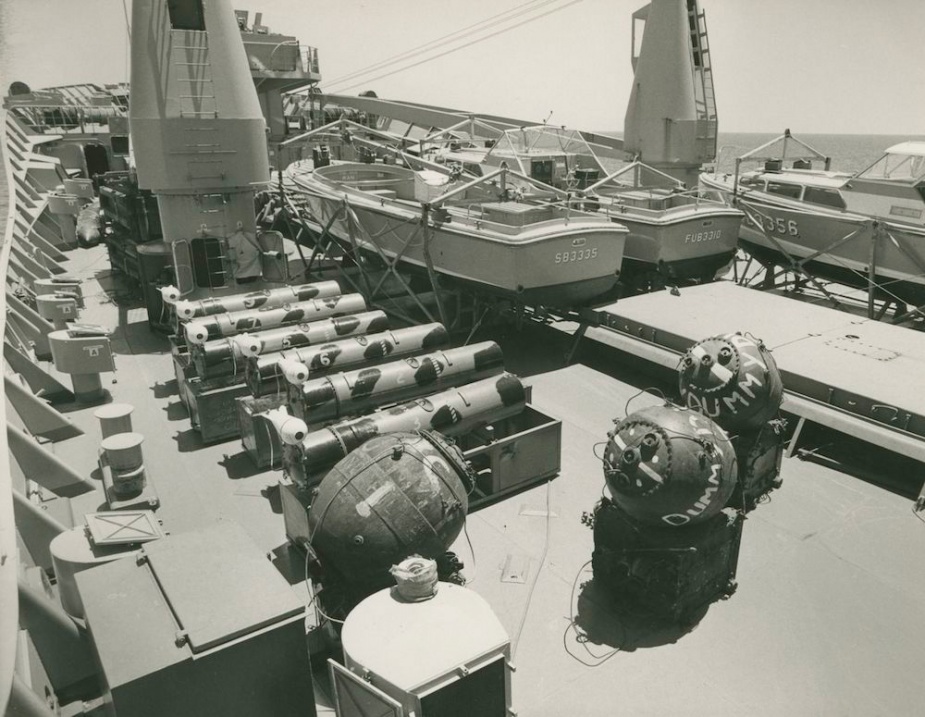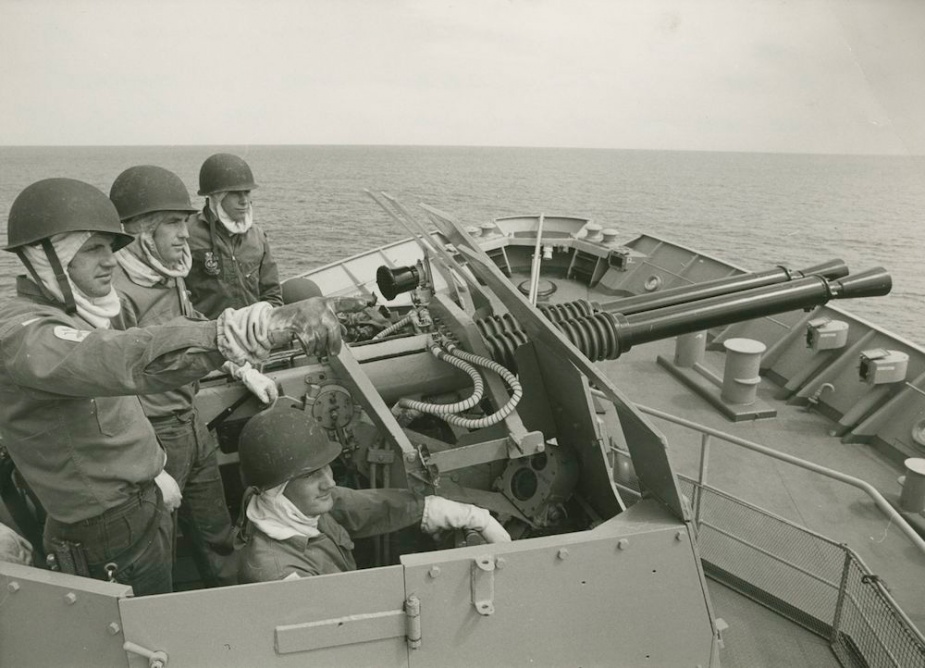HMAS Stalwart (II)
| Class |
S Class |
|---|---|
| Type |
Destroyer Tender |
| Pennant |
D215 |
| Builder |
Cockatoo Docks and Engineering Co Ltd, Sydney |
| Laid Down |
23 June 1964 |
| Launched |
7 October 1966 |
| Launched by |
Lady Casey, wife of the Governor-General |
| Commissioned |
9 February 1968 |
| Decommissioned |
9 March 1990 |
| Dimensions & Displacement | |
| Displacement | 15,500 tonnes |
| Length | 515 feet 6 inches |
| Beam | 67 feet 6 inches |
| Draught | 20 feet 1 inch |
| Performance | |
| Speed | 20 knots |
| Complement | |
| Crew | 25 officers, 392 sailors |
| Propulsion | |
| Machinery | 2 x 6-cylinder Scott-Sulzer Diesels of 7000 hp driving twin screws, developing 10,740 kW |
| Armament | |
| Missiles | Fitted for, but not with Seacat AA missile systems |
| Guns | 2 x 40mm Bofors AA |
| Helicopters | 1 utility helicopter (Wessex; later Sea King) |
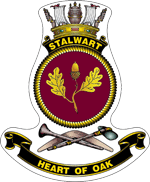
Stalwart (II) was the second Royal Australian Navy (RAN) ship to carry the name. The first was an S Class destroyer of 905 tons armed with 3 x 4-inch guns and 4 x 21-inch torpedo tubes. Stalwart (I) and four sister ships were transferred from the Royal Navy in June 1919, spending the majority of their RAN service life in port and on the east coast of Australia. Stalwart (I) paid off into the Reserve on 1 December 1925 and was sold to Penguins Ltd of Sydney for breaking up.
Stalwart’s career in brief
Stalwart’s keel was laid at Cockatoo Island Dockyard, Sydney, on 23 June 1964. The then Minister for the Navy, Mr Chaney, stated that the Escort Maintenance Ship would be of particular importance to the Royal Australian Navy because it would greatly increase the Navy’s self-sufficiency and its scope for ‘afloat support’. It would enable warships to operate for long periods away from their home ports. For this purpose Stalwart was fitted as a mobile base facility allowing vessels coming alongside to ‘shut down’ and have repairs carried out that would normally be provided by a shore base. Stalwart was able to supply such essential services as fresh water, steam, electricity and telephone communication.
Stalwart was the largest naval vessel wholly designed and built in Australia. With Captain Geoffrey Gladstone, DSC*, RAN as her first Commanding Officer, she was commissioned into service in a traditional ceremony at Garden Island Dockyard (GID) on 9 February 1968.
After trials and a working up period, Stalwart commenced duty as the RAN’s escort maintenance ship in March 1968. During her career she served in Australian and Southeast Asian waters as well as Papua New Guinea and New Zealand. Later in her career she served as the Fleet flagship and also as a training ship.
Highlights of Stalwart’s career include a deployment to Darwin in January 1975 as part of the Navy’s contribution to relief efforts in the aftermath of Cyclone Tracy. She was present at the celebrations to mark the granting of independence to Papua New Guinea in September 1975. Stalwart was again involved in disaster relief in June 1986, on this occasion in Honiara; and in September 1986 she hosted a Cabinet meeting at sea.
Stalwart also took part in two precautionary deployments in the South Pacific following the outbreak of civil disturbances in Fiji (Operation MORRIS DANCE) in May 1987 and Vanuatu (Operation SAILCLOTH) in May 1988. Stalwart was decommissioned on 9 March 1990. It is interesting to note that her first Commanding Officer, Rear Admiral Gladstone AO, DSC*, RAN (Ret’d), was also present at the ship’s decommissioning on that day.
Equipped for her maintenance role
As designed, Stalwart’s engineering, electrical, weapons, shipwright and other workshops equipped her to maintain up to four destroyers or frigates simultaneously. She was fitted with five 3-ton and one 6-ton FAVCO cranes for lifting heavy machinery parts and stores over the ship's side and into heavy duty automatic lifts which provided access to storerooms and workshops. Stalwart was designed with wide passageways to allow the flow of equipment and stores. A number of battery powered trolleys were used to transport heavy equipment around the ship. Being a Sydney-based ship, her main thoroughfare was named George Street.
Five diesel generators provided power to operate cranes, lifts, workshop equipment and domestic requirements. In addition to her own needs, Stalwart was also able to produce power for ships refitting alongside. Her hatches and watertight doors were electro-hydraulically operated, and could be controlled from the bridge. A fully automatic telephone exchange was fitted for her own needs and also for ships alongside.
Stalwart’s evaporators were capable of producing up to 350 tons of condensed fresh water from the sea each day; and a steam boiler was fitted to provide steam for the evaporators, domestic use and for ships alongside.
Boats were seen as essential to enable the ship to carry out her role, particularly when away from her home port. Stalwart carried four 40-foot, 40-man powerboats, two 26-foot utility boats, a 26-foot sea boat, and a diving boat.
Stalwart’s flight deck was capable of operating every type of helicopter used by the RAN and she she was fully air-conditioned and designed to enable a high standard of living and sleeping accommodation. Stalwart was equipped with a modern galley, chapel, classroom, laundry and gymnasium, plus excellent medical facilities. The sickbay area included a waiting room, examination room, dental surgery, dispensary, doctor’s office, two wards, and a fully equipped operating theatre.
Stalwart’s ship’s company included the various specialists in the numerous RAN trades and professions. In fact more than 75% of her complement were engaged in repair and maintenance tasks.
Because Stalwart spent much of her time secured to the Escort Maintenance Ship (EMS) mooring at Garden Island Dockyard in her maintenance role, she was, for a period, derisively referred to within the RAN as Building 215 - in reference to her pennant number. Later she was used to her full potential when she assumed the role of RAN flagship following the decommissioning of HMAS Melbourne (II).
1968
Stalwart’s first year in commission was busy, commencing with a demanding trials and workup period. This was followed by her maiden cruise, visiting Hobart, Adelaide, Fremantle and Melbourne. In Hobart, the ship’s Australian Rules team took on a team from Hutchins, one of the city’s leading public schools. Unfortunately for the ‘Warts’ team, their opponents were the better team on the day. Perhaps the presence of the TV cameras were a distraction early in the game; but mercifully the TV crews had left before the final scores went up on the board.
In September 1968, 54 warships of the RAN, RN, RNZN and USN took part in Exercise CORAL SANDS; at that time the largest Australian-directed maritime and amphibious exercise held in Australian waters. Stalwart was one of the 25 RAN units taking part in this exercise, which included an amphibious landing by Royal Marines in Shoalwater Bay, who were opposed by an ‘enemy’ force made up of Ghurkha troops. Exercise CORAL SANDS finished on 14 October 1968, with a ceremonial fleet entry into Sydney Harbour, involving 10 ships from four navies.
The year concluded with the ship undergoing leave and maintenance at Garden Island Dockyard and a change of command when Captain Antony Cooper, RAN joined on 16 December.
1969
Stalwart’s year commenced on a high note with the Flag Officer in Command Australian Fleet, Rear Admiral Gordon Crabb, awarding the Duke of Gloucester’s Cup, the annual award presented to the most efficient RAN unit, to the ship for her performance during 1968.
The first six months of 1969 saw Stalwart mostly undertaking her designed role; that of maintaining destroyers and frigates. During this period she underwent a docking to have her hull cleaned. The Navy News of 4 April 1969 provides the following snippet:
The Destroyer Tender...moved into the Captain Cook Dock to have her hull scraped clean and painted...The occasion also coincided with the 24th birthday of the dock. Oddly enough, Stalwart’s Commanding Officer, Captain AH Cooper, RAN, happened to be on the scene 24 years ago when the Duke of Gloucester officially opened the Captain Cook Dock. Captain Cooper then was the Executive Officer of the frigate HMAS Lachlan, which was the first ship to officially use the dock...Each time a major docking is undertaken, 57 million gallons of water is pumped out of the dock.
The remainder of the year saw Stalwart undertaking visits to Auckland, Brisbane and Adelaide, interspersed with short periods in her home port of Sydney. A very popular family day was included in the ship’s program in mid-November. The ship ended the year as it began, at Garden Island for maintenance and leave.
1970
Now under the command of Captain John Goble, Stalwart undertook a short visit to Hobart in early February, where she acted as flagship during the Hobart Regatta. On 10 February, the ship celebrated her second birthday with a special cake, which was cut by Ordinary Seaman John Jones, the youngest member of Stalwart’s ship’s company.
Stalwart returned to Sydney on 13 February, sailing again the next day for a family sea day. According to the ship’s Navy News correspondent:
...the sea was kind and the Fleet Band provided excellent entertainment...Due to the excellent organisation of Lieutenant Jack Cottrell, a pirate’s cave was set up, which provided many a pleasant surprise for the young and not so young.
The period mid-February to early May was spent at Garden Island maintaining destroyers and frigates. On 9 May, Stalwart departed Sydney, on passage to Singapore. Northward-bound, within a few days, there was a change of rig from No.8s to shorts and sandals. In the Flores Sea, the ship answered a call for medical assistance from the Shell tanker, Horomyn. This resulted in John Young, a steward aboard Horomyn, being transferred to Stalwart and an operation being carried out in the ship’s medical facility. Stalwart arrived in Singapore on 21 May, berthing at Sembawang, the Royal Navy Dockyard on the northern end of the island, about 20 kilometres from the city centre.
While ‘up top’, Stalwart, together with more than 30 ships of the Australian, British, Malaysian and New Zealand Navies, took part in Exercise CRACKSHOT, a major five-power maritime exercise. Exercise BERSATU PADU followed next for Stalwart, an exercise involving ships, aircraft and land forces of five nations. The exercise included mass attacks on the fleet by Royal Air Force aircraft, including Vulcan jet-bombers.
Stalwart and other RAN units returned to Sydney on 15 July 1970, to be met by rolling stoppages by Garden Island Dockyard boat crews, which meant that the ships could not berth alongside. From the Navy News edition of 24 July 1970, “The strange sight of Australia’s largest warship, Melbourne (II), being forced to drop anchor off Garden Island, and Stalwart wandering around Sydney Harbour trying to find a berth was one outcome of the strike.” With thousands of relatives waiting at Garden Island, the Navy mobilised all available small boats and landing craft from ships and establishments plus civilian ferries, to get sailors ashore as soon as possible.
Following her return from ‘up top’, Stalwart spent the period to mid-October in assisted maintenance. This was followed by Exercise SWAN LAKE, which saw Stalwart and other RAN units exercising with Royal Navy ships in the first major peacetime operation to be held in the Indian Ocean. The exercise was designed to test the versatility of integrating ships of the two navies, and to demonstrate the practicability of deploying ships from Australia’s east coast to the West Australian area. A visit to Melbourne provided a welcome break before Stalwart returned to Sydney for Christmas. The ship ended the year alongside Garden Island for maintenance and leave.
1971
In January 1971 Captain Neil Boase, RAN, assumed command of Stalwart during a scheduled maintenance period that ended in late March. The ship then undertook a short visit to Brisbane from 1-5 April, before returning to her home port, where she remained undertaking her maintenance role until 3 August. Her next programmed activity was exercises in the Eastern Australia Exercise Area (EAXA) during the period 5-9 August, before returning to her usual berth at Garden Island until late November. The Grand Ballroom at Sydney’s Wentworth Hotel was the venue for Stalwart’s ship’s ball on Friday 8 October.
In late November 1971, the RAN was honoured by the city of Williamstown in a Freedom of Entry ceremony, and Stalwart deployed to Williamstown for the occasion. The ceremony saw over 500 sailors march along Ferguson Street, Williamstown. Stalwart and other ships berthed at Williamstown were open to the public during the visit, and over 15,000 visitors took the opportunity to visit the dockyard. Stalwart ended 1971 at Sydney’s Garden Island Dockyard for leave and maintenance.
1972
On completion of leave and maintenance, Stalwart together with the fleet flagship, Melbourne, Supply and destroyers Duchess and Hobart, departed Sydney on 27 January for a Southeast Asian deployment. Her fourth birthday was appropriately celebrated on 9 February, with a special cake, “somewhere at sea” en route to the Philippines.
On 15 February, in the South China Sea, Exercise SEA HAWK began, with ships, submarines and aircraft from Australia, Britain, New Zealand, the Philippines, Thailand and the United States, taking part. Stalwart was one of nine RAN units participating in this major international exercise.
On conclusion of Exercise SEA HAWK, Stalwart sailed across a somewhat stormy South China Sea for her first visit to Hong Kong during 1-10 March 1972. The crisp, cold air of ‘Honkers’ was a very pleasant change from the steamy, tropical humidity of the Philippines. During the visit, as per tradition, Jenny’s Side Party was employed painting the ship.
Following a port visit to Subic Bay, Stalwart returned to Sydney on 23 March on completion of a successful deployment.
In late August, Stalwart departed Sydney for her second Southeast Asian deployment in 1972, visiting Port Moresby and Darwin en route to Singapore. In September, Stalwart took part in joint Exercise SAPU BERSEH. This was closely followed by participation in Exercise SEA SCORPION in the South China Sea. This exercise involved ships and aircraft from six SEATO nations; with Stalwart being one of eleven RAN units taking part.
During the visit to Manila, a donation of medical supplies, purchased by Stalwart’s ship’s company, was presented to the Philippines National Red Cross, and a gift of presents was made to needy children at a local charity. Returning home, a kite-flying competition from the flight deck in the South China Sea saw one kite reach the dizzy height of 500 feet. Stalwart returned to Sydney in mid-November, undertaking leave and maintenance until early February 1973.
1973
The year commenced with Stalwart at Garden Island undergoing leave and maintenance and Captain Ian Broben, RAN took command on 4 January. This was followed by a visit to Hobart for the Hobart Regatta. En route to Hobart, Stalwart, with Anzac, took part in an unsuccessful search for the Japanese trawler Nisshin Maru No. 8 which had sunk off Pedra Branca, south of Tasmania, on 7 February. No sign off the trawler was found although one survivor, from her crew of 22, was later found by another search vessel on Pedra Branca and he advised the trawler had sunk in less then five minutes during a storm.
The opening of the Wrest Point Casino rather overshadowed the Hobart Regatta, but the strong RAN contingent, which included Onslow and two patrol boats in addition to Anzac and Stalwart, enjoyed the festive atmosphere created by both events.
During the visit to Hobart, the ship’s birthday was celebrated with the traditional birthday cake, which was cut by the youngest member of Stalwart’s ship’s company.
A short but pleasant visit was made to Wellington, New Zealand, in late March, followed by a port visit to Brisbane in early April. Stalwart’s year continued its planned course with her return to Garden Island for escort maintenance activities at the EMS mooring.
In September, Stalwart, together with Perth and Vampire, made a return visit to ‘The land of the long, white cloud’, to participate in Exercise LONGEX 73, a multi-national exercise involving ships from New Zealand, the Netherlands, Britain and the United States.
The ship first visited Wellington, where the Australian High Commissioner, Dame Annabelle Rankin, embarked for the two-day passage to Auckland. She was the first woman to travel overnight in an RAN ships since 1967, when the then Prime Minister, Mr John Gorton, and Mrs Gorton, with the Australian Commissioner to Fiji and his wife traveled in Anzac on a visit to Tonga for the King of Tonga’s coronation. With the High Commissioner safely disembarked, and following an enjoyable visit to Auckland, the ship took passage north to the picturesque Bay of Islands area. Stalwart returned to Sydney in early October to take part in Exercise SECOND CHANCE, and for Navy Week.
October 1973 marked the 60th Anniversary of the RAN’s first entry into Sydney Harbour. In 1973, however, due to the RAN’s involvement in the official opening of the Sydney Opera House, by Her Majesty Queen Elizabeth II, Navy Day was celebrated on 21 October. Garden Island Dockyard’s open day saw seven RAN ships, including Stalwart, open to visitors.
Stalwart’s year finished with the ship in self maintenance, followed by Christmas leave.
1974
Stalwart’s operational year commenced with Exercise SOUTHERN CROSS in late January. This was a joint operation off the NSW coast, involving RAN and Indonesian Navy units. The Flag Officer Commanding the Australian Fleet, Rear Admiral Anthony Synnot, and the Commander of the Indonesian Fleet, were aboard Stalwart for part of the exercise. Exercise SOUTHERN CROSS concluded on 25 January, when three RAN ships, including Stalwart, in company with three Indonesian Navy ships, made a ceremonial entry into Sydney Harbour.
The period 25 January to 20 May was spent undergoing refit and trials. This was followed by Exercise KANGAROO ONE (3-17 June 1974) in the Coral Sea and off the Central Queensland coast; one of Australia’s largest peacetime exercises involving units from four nations. Some 22 RAN units, including Stalwart, were involved in this demanding 14-day exercise, plus ships from New Zealand, the United Kingdom and the USA. For those who like statistics the exercise involved 15,000 servicemen, 38 ships, and nearly 121 aircraft.
On completion of KANGAROO ONE, Stalwart returned to Sydney for more mundane maintenance activities at the Garden Island EMS mooring. Her year then took its planned course with a visit to Tasmania in mid-October for Exercise COLD CIDER, plus port visits to Hobart and Melbourne before returning to Sydney. She was next involved in Exercise WARM WATERS off Queensland, followed by visits to Brisbane, Port Clinton, Marble Island, North Keppel Island, and Gladstone.
Stalwart returned to Sydney in late November for escort maintenance activities, with her ship’s company looking forward to Christmas and leave.
In the early hours of Christmas Day 1974, however, Cyclone Tracy struck Darwin with the strongest winds ever recorded on the Australian mainland, leaving 49 officially dead, most of Darwin’s 43,000 people homeless, and damage totaling at least $850 million. Early on Christmas Day, the recently established National Disasters Organisation (NDO) received news of the catastrophe when a Darwin police officer told director, Major-General Stretton “...Darwin’s been blown to pieces...for God’s sake send help...” This was the last direct contact with Darwin for some hours because of communications problems; but was sufficient for the NDO to trigger a national emergency relief operation.
Navy personnel on Christmas leave from their ships, from all around Australia, heeded the call and left their homes and families to return to their ships. Operation NAVY HELP DARWIN was under way with the aim of providing support to Darwin, to assist in the rehabilitation of the city, and to generally provide the maximum assistance to Darwin’s people.
Garden Island Dockyard assumed almost a wartime atmosphere as the Fleet was prepared and mobilised over two short days. Within just 24 hours three ships, Melbourne, Brisbane and Stuart had sailed. They were followed a day later by Stalwart, Supply, Hobart and Vendetta, loaded with more relief supplies to back up the advance guard.
Stalwart’s Navy News reporter provided this report:
Stalwart, commanded by Captain IM Burnside, sailed for Darwin on December 27 after 36 hours loading stores and emergency materials, particularly building and electrical equipment. Where necessary, the equipment was overhauled en route. During the voyage north, the ship’s company was surveyed to identify non-service skills relevant to the task ahead. The results were must successful, revealing skills such as bulldozer drivers, heavy equipment operators, licensed house wirers, electrical linesmen, auto electricians, motor mechanics, fencers, tilers, carpenters and joiners. Operation NAVY HELP DARWIN for Stalwart commenced in earnest on arrival in Darwin on January 2 with the landing of 150 personnel organised into clearing and salvage teams. While clearing work continued throughout, its intensity eased as Stalwart, with its unique facilities and the concentrated expertise of the ship’s company were increasingly called on to contribute towards skilled tasks. A list of Stalwart’s major undertakings gives an indication of the diversity of the work -
- Electrical and communications restorations such as high and low tension power lines, re-connecting house supplies, restorations of the Naval Communications Station, utilising and installing generators transported by Stalwart, in emergency locations, electric motor repairs in the ship’s workshops and repair of PMG equipment.
- Boat repairs, including the recovery of equipment from HMAS Arrow which sank at Stokes Hill Wharf, various repairs to the patrol boats, Attack, Assail (I) and Advance, restoration of patrol boat facilities and slips, repairs to the Darwin pilot vessel and maintenance of Task Force Group ships.
- Re-roofing of many private and public buildings, including the Technical College, Aboriginal College, Quarantine Service buildings and the residence of the Naval Officer Commanding Northern Australia, which was used as Shore Command Headquarters.
- Effecting structural repairs to various Government and commercial buildings, including Darwin Hospital, Rapid Creek laundry, St John Ambulance depot and Red Cross Centre.
- Repairing machinery, engines and equipment, such as pipelines, air conditioners, chain saws, motor vehicles and transport equipment.
- Two Wessex helicopters operated from the ship, providing invaluable assistance in the lifting and shifting of heavy materials.
In all, Stalwart spent 12 days on passage to and from Darwin and 29 days alongside at Darwin. During these 29 days, it was estimated that an average of almost 1000 man-hours per day, were directly channeled to Operation NAVY HELP DARWIN. In addition, other members of the ship’s company worked long hours on board in support roles, including providing stores, food, water, transport, communications and manufacturing equipment. The formal part of Operation NAVY HELP DARWIN came to a close on January 30 with Navy’s presentation of an inscribed shovel and a Darwin beer ‘stubby’ to the relieving Army regiment. In return, the Army presented a broom - cut down the centre - with an inscription “to the swabbies, for a job half done.” The Commanding Officer of HMAS Stalwart, Captain Burnside, at the colourful ceremony, turned over control of the shore clean-up to the army officer in charge of 5/7 RAR, Lieutenant Colonel O’Donnell.
The Naval Board recognised Navy’s efforts in the following signal:
With the withdrawal of ships of Task Force 327 from Darwin, the Naval Board wishes to express its appreciation of the magnificent work by all concerned in Operation NAVY HELP DARWIN. Personnel from Coonawarra, Melville, the Darwin-based patrol boats, Task Force 327 have borne the brunt of the task under very trying conditions...The efforts of all concerned have been in the best traditions of the Service and have attracted a great deal of well deserved recognition and acclaim. Well done.
Darwin’s mayor, ‘Tiger’ Brennan also commended the Navy for its efforts, “I will not forget you. We owe the Navy the greatest debt of all.”
1975
Following her return to Sydney from Operation Navy Help Darwin, Stalwart undertook an Assisted Maintenance Period (AMP) at Garden Island and Captain John Robertson, OBE, RAN took command on 18 February 1975.
In early August Stalwart undertook a 10 day Embarkex, to test Navy’s ability to transport and sustain an army contingent. She embarked two army units, together with a large number of vehicles, trailers and provisions; then sailed for Brisbane. Following the ship’s arrival in Moreton Bay, the army contingent disembarked into lighters. Stalwart then moved up the Brisbane River, berthing at New Farm. During the visit, the Governor of Queensland, Air Vice Marshal Sir Colin Hannah, paid an official visit; and the ship’s band gave a lunchtime concert in the city.
Departing Brisbane, Stalwart re-embarked one Army unit then made a rather rough passage home to Sydney, with Commanding Officer’s Divisions en route.
Stalwart’s next deployment was to New Guinea, where she arrived in Port Moresby on 14 September to take part in celebrations to mark Papua New Guinea’s independence. The ship provided a guard for the ceremony on 15 September, and the RAN band took part in an impressive massed band display. At midnight, the beginning of Independence Day, Stalwart honoured Papua New Guinea (PNG) with a 101 gun salute in unison with a display of fireworks from Independence Hill, which overlooks Port Moresby.
The Minister for Defence hosted a dinner aboard Stalwart, which was attended by several of Port Moresby’s local identities, including the new PNG Minister for Defence. The trip was a successful exercise in diplomacy and a rare opportunity for Stalwart’s crew to witness such an historical event in world affairs. The ship subsequently received praise from the Minister for Defence, Mr Bill Morrison, for her participation.
During the trip, Wessex helicopter 820 from 817 Squadron made her 1000th landing on Stalwart’s flight deck. The ship’s Navy News correspondent noted that the ship’s ‘flying dentist’, Lieutenant Commander Alan Kyd, maintained his enthusiasm for all things aviation, by being aboard the Wessex for a significant number of the flights made during the deployment.
Stalwart’s Petty Officer Peter ‘Banyan’ Bannon featured in Navy News in December 1975 with a display board featuring a rope anchor as its centrepiece. More than one mile of rope was used; knotted more than 19,000 times! The ship ended the year alongside Garden Island for maintenance and leave.
1976
Stalwart spent the period to mid-March at Garden Island. This was followed by participation in JUC 96, a joint-service operation in the Eastern Australian and Bass Strait areas during 15-24 March.
According to her Navy News reporter:
...through lucky rolls of the dice and successful tactical manoeuvring Stalwart avoided serious ‘casualty’ from enemy forces, and the embarked Wessex helicopter flight provided stalwart service in delivering mail and personnel throughout the exercise.
Stalwart, together with Perth, then took passage to Hobart for a four-day port visit. Obviously a visit to Hobart wouldn’t be complete without a ‘run ashore’ to the Wrest Point Casino, but one of the highlights of the visit was the Tasmanian Military Tattoo, which included precision drill performances by the drill team from Rutgers University. Stalwart departed Hobart for Sydney on 28 March, taking part in a submarine exercise en route. A call for medical assistance from the submarine saw Stalwart’s Wessex transfer the patient to the ship’s sickbay before the aircraft departed for Nowra.
It was reported in Navy News that Stalwart sailed from Sydney on 1 April with an excess crew of more than 300. The occasion was, of course, a family day, Stalwart’s fourth since she commissioned in February 1968. Thanks to fine weather, smooth seas, music provided by the Fleet Band and a first class lunch; the guests and relatives thoroughly enjoyed their trip from Sydney to Broken Bay.
The ship’s Navy News correspondent noted, tongue in cheek, that Stalwart, or Building 215, as she is facetiously referred to around Garden Island, slipped quietly away from her ‘foundations’ - the dockyard’s EMS mooring - on 8 June and headed across the Tasman for a 7 day visit to Auckland, New Zealand. The citizens of Auckland proved to be wonderful hosts to the ship’s company; and in addition, over 2000 visited the ship. Stalwart’s sporting teams performed well, but with little success in soccer, rugby or basketball. The social/sporting event of the visit was the hockey match against New Zealand Navy WRENS.
A period back in Sydney followed, for AMP and escort maintenance activities.
On 26 August, Stalwart, with the Fleet Commander, Rear Admiral Geoffrey Gladstone embarked, took passage to New Caledonia, for a short port visit to Noumea. Thanks to advance publicity by the Australian Consul, there was a high level of interest in the ship’s visit. In fact, during the open day more than 3500 people visited the ship. The ship was prepared for this onslaught with “Welcome Aboard” pamphlets translated into French! Two of Stalwart’s crew, Petty Officer Jacques Albert and Able Seaman Noel Frichot, were much in demand as they were fluent French speakers, having migrated to Australia from the Seychelles. Despite the occasional language problem, the ship’s company enjoyed the stay, the sightseeing and duty free shopping. In fact, the general opinion was “Très Magnifique!”
On 26 September, Stalwart was the venue for the Navy Week 1976 press reception, with all major Sydney media represented. The media obviously publicised the event well; during the Navy Week Open Day more than 6000 visitors toured the ship, to see what they receive for their taxes.
Stalwart’s next operational task was participation in the ANZUS Exercise KANGAROO 2 (K2), during September/October 1976. K2 involved nearly 11,000 troops of the Australian, New Zealand and US Armed Forces, over 40 ships, and 250 aircraft. Stalwart, with her unique capabilities, had an important role during the exercise and some of her tasks included troop transport, cargo vessel and minelayer; while the ship’s flight was fully involved with ferrying passengers and cargo, plus surveillance and intelligence flights.
This was a busy period for the ship. On 28 September, while the ship was at anchor in Jervis Bay, there was a change of command, with Captain John Robertson handing over to Captain Michael Hudson. Also on the agenda during this period were a change of executive officer and departmental Inspections prior to ‘Admirals’.
Shortly after Captain Hudson took command on 28 September, a signal was received detaching Stalwart to rescue two people stranded on Bellona Reef, 900 miles north east of Sydney. A certain amount of consternation was felt in the ship, as the ship’s ball was booked for 1 October. It's reported that one young sailor was seen wandering the ship in a daze, as he was due to be married on 2 October. Fortunately a further signal was received indicating that Stalwart was not needed, resulting in audible sighs of relief being heard throughout the ship.
With Exercise K2 under her belt, and following a post-exercise concert party, Stalwart set out on her first circumnavigation of Australia; with port visits to Darwin, Fremantle, Adelaide and Melbourne. At every port, industry leaders and visitors showed a keen interest in Stalwart’s extensive workshops. The ship’s three day visit to Darwin coincided with that city’s Navy Week, which saw Stalwart’s boat deck being used as the venue for the Naval Officer Commanding Northern Australia’s Navy Week cocktail party. During the visit, cricket, basketball, softball, water polo and tennis matches were contested with mixed results.
Stalwart’s Admiral’s inspection was carried out with the ship alongside the new West Australian Naval Support Facility (HMAS Stirling). On completion, the ship slipped and proceeded to Fremantle for a weekend visit, joining other fleet units already there. A mini-Olympics was held at HMAS Leeuwin with teams from the other six ships, Leeuwin and Stalwart taking part. Result: the combined Stalwart-Supply team won every event contested, with a trophy being presented by to prove it. The weekend also saw two Open Days and a fleet reception held aboard Stalwart. The visit culminated in a ‘Shop Window’ a visit to the ship for VIPs and junior recruits.
Stalwart’s next port of call was Adelaide, where she berthed with Torrens and Stuart berthed outboard. From arrival until departure four days later, the ship was literally swamped with offers of hospitality, and the ‘Dial-a-Sailor’ program was tremendously popular. Organised visits to the ship by schools, sea scouts, staff college students and apprentice groups were a very successful public relations exercise; as were two open days, when over 5000 visitors toured the ship. For the ship’s company, tours of the Barossa vineyards were very popular.
On 3 December, Stalwart arrived in Melbourne, her last port of call; where the previously good weather was replaced by high winds and rain. This didn’t dampen the enthusiasm of the libertymen, who streamed ashore to make the most of Melbourne. Bus tours to some of Melbourne’s famous breweries were booked out. Stalwart departed Melbourne on 7 December, headed for Sydney and the Christmas leave period.
1977
Stalwart’s ninth birthday was celebrated in early February, with a special cake inscribed “It’s been great since ’68”. For those who like statistics, in her nine years the ship had steamed 132,167.36 nautical miles, and some 3843 ship’s company had served in her. The period to early June 1977 was spent in the dockyard for a ‘haircut and paint’. On completion of the refit, Stalwart returned to her usual fleet maintenance and support activities.
The next event of note was when the ship transited north to Brisbane for a port visit during 9-14 June. Highlights of the visit included bus tours to the Gold Coast, a visit by the Governor of Queensland, Commodore Sir James Ramsay, and the Lord Mayor of Brisbane and his wife, who embarked for the trip down the Brisbane River.
For the return passage from Brisbane, Stalwart was privileged to wear the Flag of the Commander Australian Fleet, Rear Admiral Neil McDonald. Following the ship’s return to Sydney, Captain Hudson handed over command to Captain David Orr on 17 June.
On 20 September, Stalwart sailed from Sydney on passage to Hobart. She anchored in Jervis Bay en route, where the sports officer arranged an afternoon of volleyball and touch football competitions on the beach. The day finished with a beach BBQ and beer issue.
In a massed nationwide tribute to Queen Elizabeth II and her Silver Jubilee, Operation JUBILEE SALUTE saw the Australian Defence Force contribute to a program of activities arranged by the Silver Jubilee Commemorative Committee in 1977, and planned to reach nearly every Australian centre of population.
As part of Operation JUBILEE SALUTE, Stalwart visited Hobart from 27 September to 2 October. Following the visit, it was reported by the ship’s Navy News reporter that it took some time for the ship’s company to recover from the after-effects of Tasmania, an illness characterised by the euphoria which usually follows a visit to the Apple Isle. The major cause of the complaint was the overwhelming hospitality of the Taswegians. According to the Navy News correspondent the only remedy for this illness was a duty run ‘up top’.
Stalwart, in company with Perth, Vampire and Swan, entered Sydney Harbour on the morning of 4 October. The ships embarked guests and then took part in an Operation JUBILEE SALUTE ‘Shop Window’ in the EAXA; before returning to Sydney in the afternoon.
Stalwart was in Sydney for Navy Week 77, which was held from 2 to 8 October 1977. This marked the 64th Anniversary of the entry of the first units of the RAN into Sydney Harbour on 4 October 1913. As part of Navy Week, the RAN mounted the changing of the guard ceremony at Sydney’s Martin Place cenotaph; a weekly ceremony normally carried out by the Army.
On 10 October 1977, Stalwart was part of a five ship task group that sailed from Sydney for Southeast Asian waters. En route the task group participated in Exercise SOUTHERN CROSS II with Indonesian ships in the Coral Sea.
Although remote from Australia, Melbourne Cup fever spread to the task group on the first Tuesday of November 1977, with the ships’ amplifiers tuned to Radio Australia. Aboard Stalwart, it was reliably reported that one of the main centres for sweeps and cup information was the ship’s laundry where Leading Seaman Wayne ‘Crazy’ Cook presided.
It was a tradition aboard Stalwart that christenings of babies of members of the ship’s company were registered on the ship’s bell, so while on passage ‘up top’, the opportunity was also taken to update the engravings. The ship’s Dental Technician, Petty Officer Bernie Paul, used his calligraphy skills to add the names of Kirk Daniel Holmes (Petty Officer Glen Holmes); Benjamin Alfred Jacobs (Sub Lieutenant Jacobs); Melissa Louise Valent (Lieutenant Valent); Victor Travis Martino (Chief Petty Officer Marty Martino); Peter Jeffery Osborne Stupple and Timothy James Stupple (Petty Officer Jim Stupple), and Karl Richard Pohlman (Surgeon Lieutenant Commander Hux Pohlman).
The five ship task group finally arrived in Singapore on 4 November, joining other RAN units. Lack of berths saw Stalwart moored out in the ‘stream’, opposite the Sembawang Dockyard. The Fleet Maintenance Unit embarked in Stalwart was one of the busiest units during the Singapore visit, working on several task group ships prior to the scheduled exercises. Members of Stalwart’s ship’s company might recall the package deal that Ansett Airlines put together for wives of members of the ship’s companies in the RAN task group. The seven-night, eight-day package cost $710, including Qantas economy class air travel, accommodation at the Hotel Singapura and sightseeing tours.
Returning from south east Asian waters, Stalwart, together with other RAN and RN ships, returned home via Western Australia. The ship broke from the task group en route and made a one day goodwill visit to Cocos Island on 3 December. Stalwart then conducted a port visit to Fremantle, during 8-10 December, before returning home to Sydney on 17 December for the commencement of the Christmas leave period.
1978
Stalwart’s year commenced with her scheduled fleet maintenance and support activities at Garden Island. She departed Sydney in early February on a 10th birthday deployment to Hobart to act as ‘flagship’ for the annual Hobart Regatta. En route to Hobart, she anchored in Jervis Bay where midshipmen from Creswell visited the ship as part of their training; and some 50 members of the ship’s company underwent firefighting training at the Jervis Bay Range Facility. In sport, the ship’s cricket team inflicted only the second defeat since February 1976 on defending I Zingari cricket premiers (HMAS Albatross).
During the passage south the opportunity was also taken to exercise with Vampire, Vendetta and the RAN’s new training ship, Jervis Bay.
The ship’s 10th birthday was celebrated in rough weather in the Tasman Sea, with a celebratory birthday cake being cut by Seaman John Dutton, the youngest member of the ship’s company, and a free beer issue.
Stalwart’s Hobart visit saw more than 1000 people visit the ship on open day, while there were victories all-round for the ship’s sportsmen in competition with local teams. The ship’s tug-o-war team capped this off by winning a hard-fought contest against Huon before a large crowd at Hobart’s Regatta Point.
Stalwart returned to Sydney for her more usual fleet maintenance and support activities during 17 February to 29 March 1978. The Commander Australian Fleet, Rear Admiral Neil McDonald, carried out his annual inspection of the ship on 15 March, following which he signalled that the ship and her ship’s company had looked very smart. “It was obvious that a great deal of hard work had been put into bringing the ship to a high standard for my inspection...A most creditable effort. Well done.”
1978 saw Stalwart celebrating a rare treble event. According to Navy News, “there are relatively common cases of brothers serving in RAN units...and father-and-son instances are not out of the norm. But in the case of HMAS Stalwart - no fewer than three brothers find themselves concerned with different aspects of the destroyer tender’s operation.” The brothers were Warrant Officer Peter Corran, Petty Officer ‘Mick’ Corran, and Able Seaman David Corran, who together had a total of 45 years’ service in the RAN.
The next deployment took Stalwart across the Tasman Sea. She departed Sydney on 29 March on passage to New Zealand, in company with Vampire and Jervis Bay. During the deployment, Stalwart’s doctor, Lieutenant Lang, transferred by jackstay to Vampire to give emergency treatment to Able Seaman Sounvell.
In addition to the usual exercises, general drills were carried out within each ship, with departments carrying out entirely different duties. Aboard Stalwart, for example, the engineering department had to bake 12 scones for the bridge staff, while the medical team had to cook an egg and chop on the flight deck for the Navigator to eat.
During this busy deployment, port visits were made to Auckland and Wellington. In Auckland a combined Stalwart/Vampire team unsuccessfully challenged a team from HMNZS Philomel for the Lou Smith Cup - a symbol of Rugby supremacy between the RAN and RNZN. The Australians went down 22-0 in a game that was never in doubt from the kick-off.
On 17 May Stalwart took passage north; a course always popular as Sydney slipped into winter. The ship was tasked, together with Supply, with Operation OIL CLEAN UP in Port Moresby. En route Stalwart spent time in the Whitsunday Passage to allow the ship’s company time to enjoy a banyan and sports ashore at picturesque Cid Harbour.
In Operation OIL CLEAN UP, a former RAN oil fuel installation at Port Moresby was emptied of 700 tonnes of fuel oil, and the tank cleaned and freed of gas. Volunteers from both ships, headed by their captains, spent long hours inside the oil tanks, finally finishing the task with buckets, mops, shovels and rags. According to Stalwart’s Navy News reporter, Petty Officer John O’Brien, “it must have been thirsty work. Stalwart alone, during the 20-day deployment, consumed 13,200 goffas (soft drinks) - some two and a half cans per day on average for each member of the ship’s company.”
On 16 August there was a change of command ceremony aboard Stalwart, with Captain David Orr handing over command to Captain Errol Stevens.
In early September 1978, Stalwart headed north once again, at the start of a 10-week south east Asian deployment, in company with Supply and Torrens. The first port visit was to Ujung Pandang in Indonesia (formerly Macassar in the Celebes). This was followed by exercises with the Indonesian Navy, and the mandatory port visit to Singapore.
During the deployment, a multi-ship anti-aircraft rapid open fire exercise took place, which resulted in Stalwart’s gunners making the claim that they are the best close range gunnery team in the fleet. The exercise saw the ship annihilating starshells with sustained fire from her Bofors anti-aircraft gun.
On 28 September, an emergency appendectomy was carried out at sea in Stalwart’s sick bay, which according to the ship’s Chief Petty Officer Medic, who perused the records back to the ship’s commissioning, was her first such operation; and it was completely successful!
The return to Australia was made ‘westabout’, with the task group, now including Vendetta, Swan, Stuart and two RAN submarines, together with ships and aircraft from the USA and New Zealand, participating in an 11-day ANZUS exercise.
The appropriately named Exercise SANDGROPER off the West Australian coast was designed to integrate ANZUS forces in joint operations. During one phase of SANDGROPER, a group of Stalwart’s ship’s company spent several days on exchange aboard the frigate, USS Knox. It was generally agreed that it was a fantastic experience, and one they wouldn’t forget.
Following the exercise, port Visits were made to Fremantle, Albany and Adelaide, en route back to Sydney. Stalwart spent the period 22 November 1978 to 12 March 1979 at Garden Island for fleet maintenance activities, plus, of course, Christmas leave.
1979
Stalwart’s eleventh year in commission commenced alongside Garden Island for fleet maintenance activities, and completing Christmas leave. On 18 January, Stalwart received a bomb threat, and consequently she and HMAS Swan, berthed alongside her, were evacuated. No suspicious objects were found.
Stalwart departed Sydney on 12 March, initially for several days workup in the Jervis Bay Exercise Areas (JBXA). In Jervis Bay, a class of Cadet Midshipmen from the RAN College joined the ship for a day of sea familiarisation. The ship’s fishermen lost no time in dropping a line while the ship was in Jervis Bay, with Able Seaman Nelson Pidd catching a 47-pound jewfish.
In Jervis Bay, on 16 March, the ship was joined by Perth, Vendetta and Derwent to become Task Unit 327.4.3. The task unit then deployed to Western Australia to take part in that state’s 150th Anniversary celebrations. The first port of call was Adelaide for a short goodwill visit, which culminated in a sea day with VIPs and media embarked.
On completion of the sea day the task unit sailed westward, but problems were not long in coming. As Stalwart’s Navy News reporter wrote at the time:
Derwent developed problems in her machinery spaces and had to return to Port Adelaide. Perth also had machinery problems, requiring Stalwart to pass feed water for her boilers. The master plan envisaged the use of the jackstay method with a fire hose attached...but fate plays strange tricks on mice and men and master. Plan Mk2 was implemented. Stalwart anchored and lowered her catamarans to enable Perth to berth alongside. Many problems were experienced...but with Perth alongside, the transfer began. Some hours after berthing Perth, she was once again on her way. After a long day and half the night, the efforts of Stalwart’s ship’s company could be best described by a signal from Perth to Stalwart: “Water everywhere, but not a drop for our boilers! But Heart of Oak saved the day, and brought joy to our toilers.”
At HMAS Stirling the task unit was joined by the survey ship HMAS Moresby and the patrol boat, HMAS Acute, making up one of the largest concentrations of RAN units since the new West Australian Support Facility had opened in July 1978.
As part of Western Australia’s 150th Anniversary celebrations, Stalwart’s ship’s company, together with those of the other visiting ships, marched proudly through the city of Perth, together with contingents from the army and air force.
Following participation in the celebrations, Stalwart retraced her course eastwards, and was in Melbourne for Cup Day 1979, finally returning to Sydney on 30 April.
It was significant that following his 1979 inspection of Stalwart, the new Flag Officer Commanding the Australian Fleet Rear Admiral David Leach, released the following signal:
I was very pleased with what I saw during my inspection of Stalwart today...The ship and its integral Fleet Maintenance Unit provides an essential element of our fleet support. This will become even more important with the introduction of our new frigates. I am confident the ship will meet these increased commitments in the future. Well done.
The ship remained in Sydney undertaking her unsung but vital fleet maintenance activities until early October 1979.
October was a busy and demanding month for Stalwart with the ship’s involvement in Exercise KANGAROO 3 (K3), in North Queensland waters. The ship departed Sydney on 2 October, in company with Derwent and Vampire, and HMNZS Canterbury, which together formed the Exercise KANGAROO 3 Orange Force surface component. Stalwart’s major role was as an advance mobile base for Orange Force units in the Coral Sea ‘war areas’. Her Commanding Officer, Captain Stevens, decided that for K3 Stalwart should be missile-equipped; and thus the ship came to the exercise armed with her own homebuilt ‘Orange Ade’ missile system. Stalwart’s Navy News correspondent reported that:
...the principle of ‘Orange Ade’ is simple. A target is selected and using the principle of opposites attracting...the missile always homes in on a Blue force unit. The missile’s warhead is full of ‘pith’. This added bonus for re-arming can be achieved by a quick trip to your local fruit shop. When the missile encounters its target, the casing of the warhead peels off some ten metres away. The enemy unit is then engulfed in a screen of ‘pith’, forcing it to ‘pith’ off.
Epitomising the Orange Force spirit of adventure, in the closing stages of K3 a group of intrepid commandos from Stalwart staged a surprise raid on Blue Forces ashore, as per this description - Stalwart’s helicopter landed a priority TV film covering valiant exploits of Orange Maritime Forces at Bundaberg on 23 October. The neutral flight then returned to Stalwart. On 25 October a heroic vertical assault by the highly trained Orange Force Landing Party was conducted on the Blue Force Forward Support Base, Bundaberg. Stalwart’s helicopter landed on the grounds of the Naval Reserve Cadet unit TS Bundaberg. Eight Orange Force Naval Commandos rapidly deployed and lured all Blue Force personnel outside of building for alleged public relations photos in front of helicopter. Six commandos then split and searched the support base buildings and simultaneously placed notional time bombs in buildings and among the Blue Force missile and armament stores. The cover story was that it was a helicopter from HMAS Melbourne collecting Blue Force public relations information for Navy News. No force was used and it was believed that the Blue Force Support Base staff were unaware that they had been destroyed.
Stalwart’s exercise also included a unique meeting with an Orange Force unit, when the submarine Otama surfaced at night close by and secured alongside Stalwart, to transfer stores and for a welcome break from the ‘world beneath’ for her ship’s company. Additionally, on one of the occasions when fishing was allowed, a first time fisherman aboard Stalwart, Able Seaman Peter Brady, managed to catch a 4-metre tiger shark. A rope noose and a winch had to be used to secure the catch so that the prized trophy, the set of jaws, could be removed.
During a break in K3, some 150 personnel from Stalwart, Vampire and HMNZS Canterbury participated in an 8-kilometre race through Townsville, which raised funds for the local Sub-Normal Children’s Association. The ship’s participation in K3 concluded with an inter-mess deck hockey competition. Stalwart’s Navy News correspondent reported that “it was the sporting event of the year, complete with cheer girls, banners, a band, full commentary and film coverage.”
Exercise observers later described K3 as the most realistic, successful exercise in the Kangaroo series, and Rear Admiral Leach concluded his appraisal of Exercise KANGAROO 3 with “Well done to the professionals of the RAN.”
Captain Ian Callaway, RAN took command of Stalwart on 29 November 1979 and the ship ended the year as it began - at Garden Island Dockyard.

